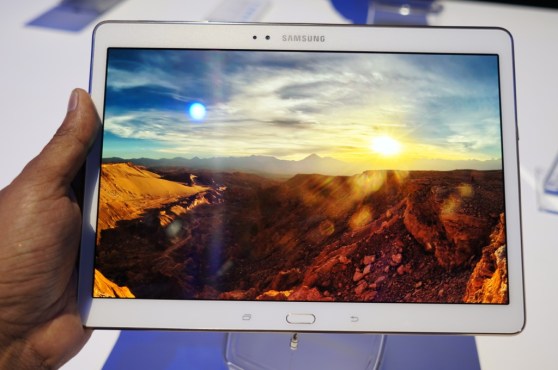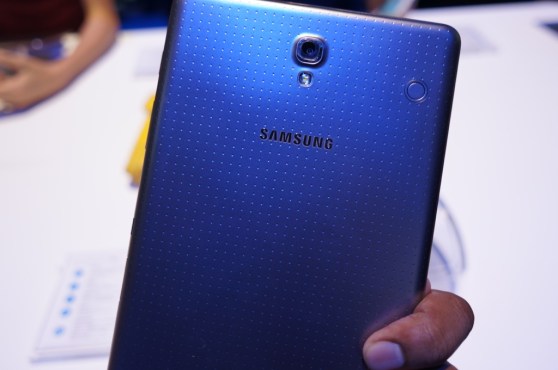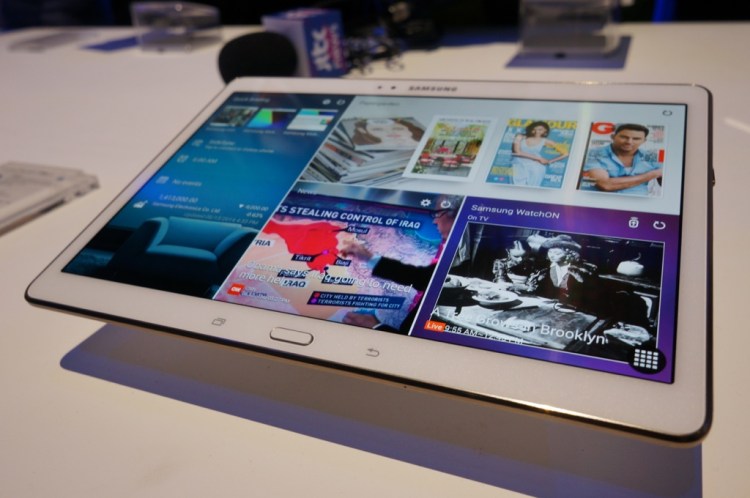Once again, Samsung is trying to make splash with big Android tablets — and this time, it’s going back to basics.
The South Korean electronics giant is one of the few tablet makers that didn’t give up on big Android slates after the 7-inch Kindle Fire and Nexus 7 took over the market, edging out many bigger models.
Now, with its new Galaxy Tab S line, Samsung forgoes the stylus from its recent Note series for something far more impressive: freakin’ gorgeous screens.
Sure, the Galaxy Tab S — available both in a large 10.5-inch version (starting at $500) and a more portable 8.4-inch version (starting at $400) — is thin, light, and powerful. But its true claim is its luscious quad-HD display, which is so crisp and clear it practically feels 3D.
But is a nice screen enough to make a truly successful tablet?
Good: Samsung’s most refined tablet yet
Just as with the Galaxy S5 smartphone, it’s clear that Samsung has learned a lot about refining its products with the Galaxy Tab S line. They feel great in your hand thanks to a slim design and faux-leather rear cover (something adopted from Samsung’s latest phones). And even though these still sport plastic cases, the overall quality of the materials feels a bit more premium than past Samsung tablets.
Both tablets also best Apple’s iPad Air and iPad Mini in several respects: They’re only 6.6 millimeters thick (the iPad Air is 7.5 millimeters thick), the 10.5-inch model is slightly lighter than the iPad Air, and the 8.4-inch model is slightly lighter than the iPad Mini. Most consumers won’t notice those slight advantages, but they give Samsung a few metrics to show it can outdo Apple.
Really, though, the main reason anyone would want either of these Galaxy Tab S tablets is for their stunning screens. Both models sport bright and colorful displays with a 2,560-by-1,600-pixel resolution — once again, slightly better than the iPad Air’s 2,048-by-1,536 screen.
You’d be hard-pressed to notice the actual pixel difference between the competing tablets, but it’s one of many reasons why the Galaxy Tab S line’s Super AMOLED screens “pop” a bit more than the iPad Air’s. Colors are brighter the iPad’s LED display, blacks are darker, and it’s easier to make out fine detail in high-resolution video.
I spent a lot of time gawking at 4K videos on YouTube with the Galaxy Tab S, and even though its screen isn’t anywhere near true 4K resolution, the video still looked phenomenal. In some instances — especially with high-quality nature documentary footage — the Galaxy Tab S screens felt practically three-dimensional. You don’t need fancy 3D glasses to feel the depth between objects on the screen. And yes, HD videos also look pretty great too.

It won’t be too long until other tablets feature similar screens, but for now Samsung (which also builds the display components for many competitors) remains a step above the competition.
I swapped between both the 10.5-inch and 8.4-inch Galaxy Tab S in my testing and found that both had their own unique strengths. The screen on the larger tablet is far more impressive and better-suited to binge watching video. The smaller Galaxy Tab S, meanwhile, is more convenient thanks to its paperback-like weight.
While I enjoyed using both tablets, I ended up favoring the larger model because it feels truly different from other large Android tablets. There’s plenty of cheaper competition for smaller Android tablets, and I figure most consumers would rather spend around $200 on a tiny 7-inch slate rather than $400 for the slightly larger Galaxy Tab S.
Both of Samsung’s new tablets are powered by the company’s latest mobile processor and 3 gigabytes of RAM. Samsung stripped down its Android skin so it’s less intrusive (something it also implemented in the Galaxy S5), and it has fewer gimmicky features to deal with. That speaks to the overall maturation of Android as well as Samsung’s own evolution as a company.
I saw around 12 hours of battery life from both tablets in my testing, which involved typical web and app use as well as loads of video streaming.

Bad: Inconsistent performance, curious pricing
Despite their powerful hardware, the Galaxy Tab S tablets sometimes choked on simple things like opening up complex apps, loading games, and switching between apps. I’m not sure if it’s due to Samsung’s software additions, or just general Android sluggishness, but it was disappointing to see in premium devices.
It’s also tough to tell if these tablets have any place in the existing market. As I’ve mentioned, cheaper small Android tablets are far more compelling than the 8.4-inch Galaxy Tab S. And even if you’re welling to throw down near $400 for a smaller tablet, the iPad Mini with Retina Display is a strong competitor.
As much as I like the 10.5-inch Galaxy Tab S, it’s hard to recommend when it’s exactly the same price as Apple’s iPad Air. Apple has had far more time to refine its tablet hardware and ecosystem, so why would anyone want to pay the same price for less?
If Samsung actually wanted to make the Galaxy Tab S tablets competitive, it should have been far more aggressive when pricing them. I’m sure it would have been difficult to accomplish, but a Galaxy Tab S line priced at $300 for the 8.4-inch version and $400 for the 10.5-inch would have given consumers a clear reason to consider them.

Verdict: Solid Android tablets — with some caveats
If you’ve got your heart set on a big Android tablet, the 10.5-inch Galaxy Tab S is your best option today.
The only problem? There don’t seem to be that many people actually looking for big Android tablets.
The Galaxy Tab S line shows that Samsung has finally landed on a big differentiating feature for its tablets — gorgeous screens — but it’s also a reminder that the company still has a lot to learn.
As much as Samsung wants to be perceived as a direct competitor to Apple, it still doesn’t make sense for it to price its tablets at Apple’s level.








